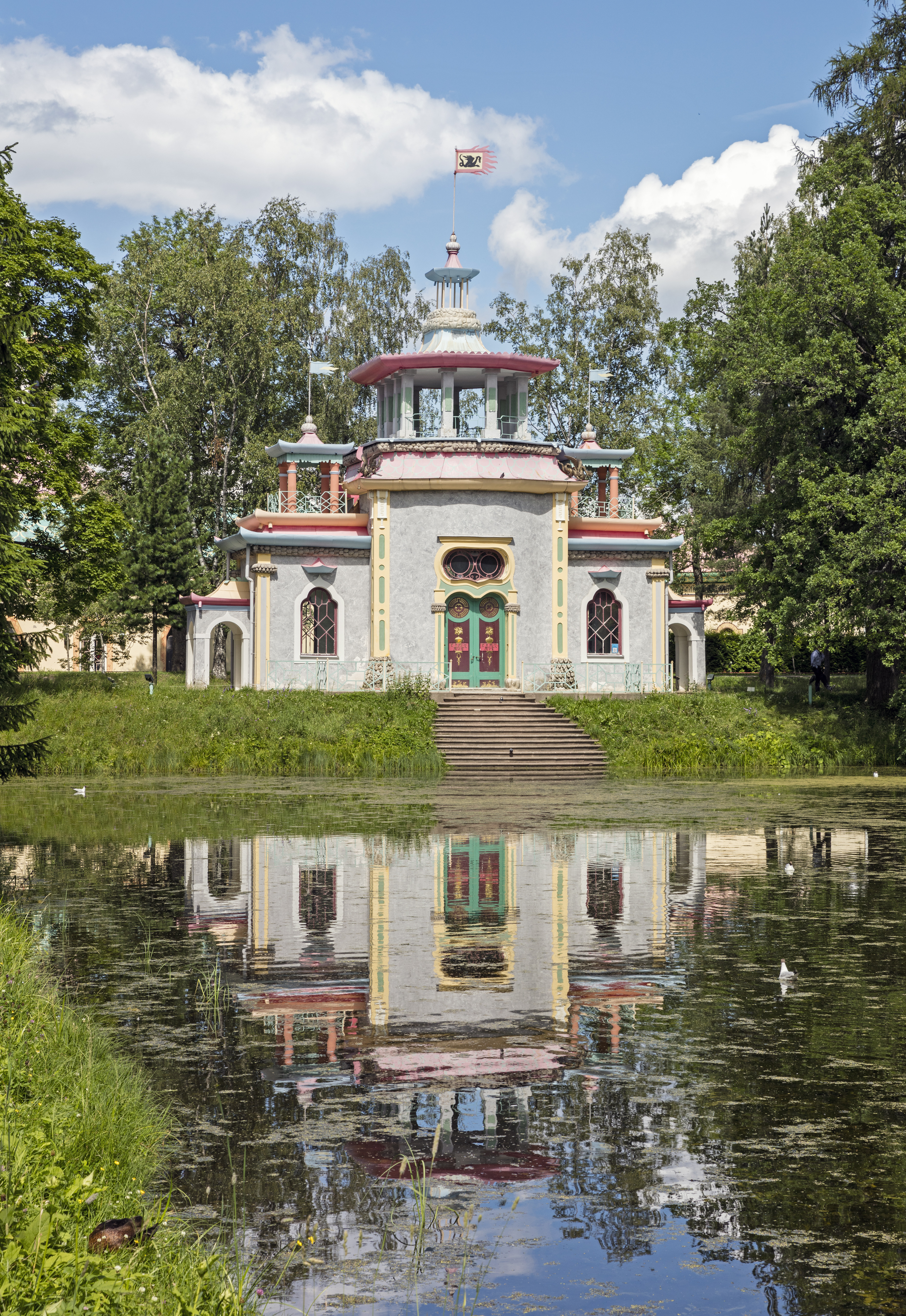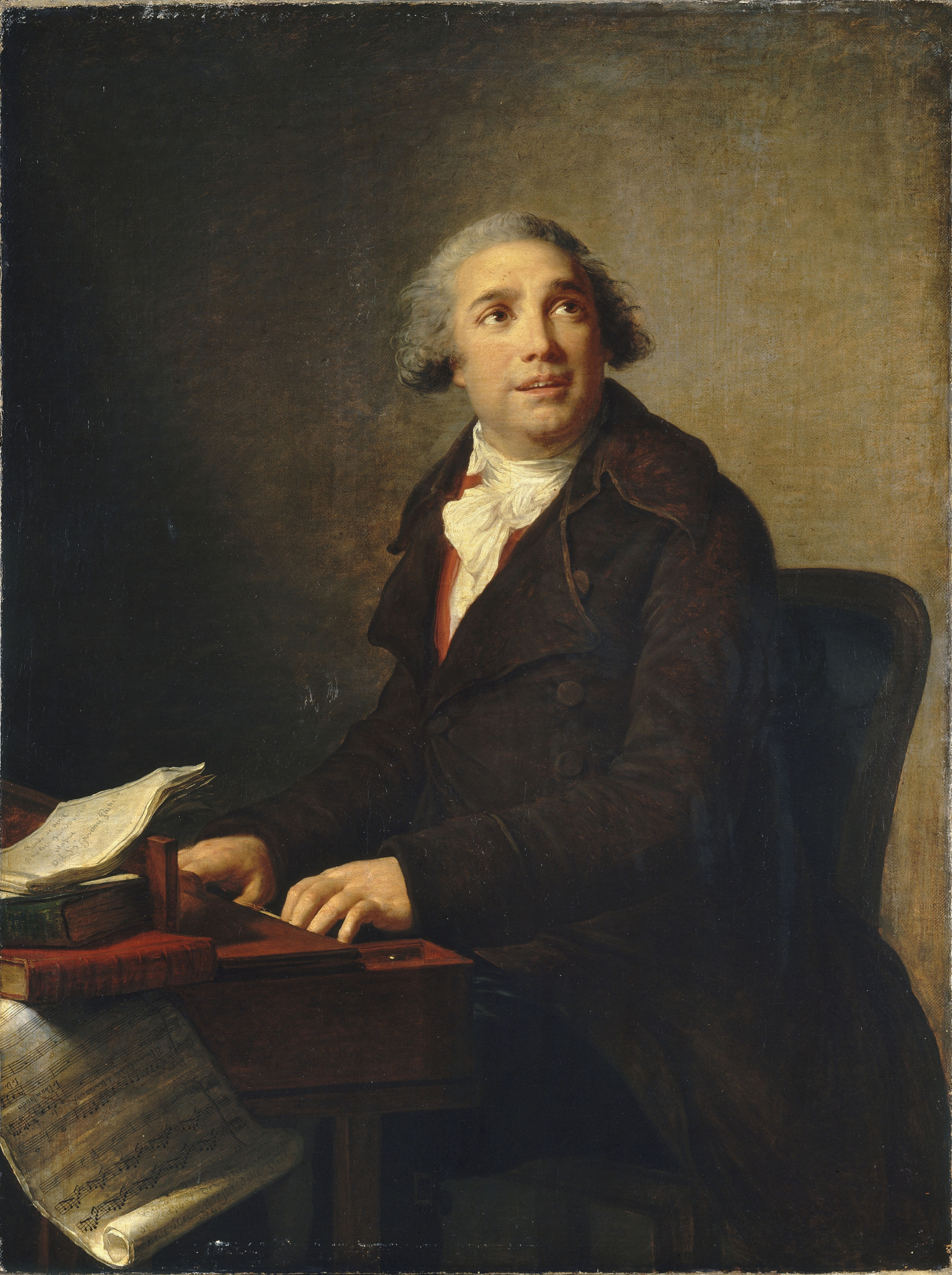|
Chinese Village
The Chinese Village in the Alexander Park of Tsarskoye Selo, Russia was Catherine the Great's attempt to follow the 18th-century fashion for the Chinoiserie. Probably inspired by a similar project in Drottningholm, Catherine ordered Antonio Rinaldi and Charles Cameron to model the village after a contemporary Chinese engraving from her personal collection. The village was to consist of 18 stylized Chinese houses (only ten were completed), dominated by an octagonal domed observatory (never completed at all). After Catherine failed in her ambition to procure a genuine Chinese architect, the Russian ambassador in London was instructed to obtain a replica of William Chambers's Great Pagoda in the Royal Botanic Gardens, Kew for Tsarskoye Selo, a central structure of the Chinoiserie architecture. Catherine's death in 1796 led to the works being suspended. It was not until 1818 that Alexander I of Russia asked Vasily Stasov to overhaul the village in order to provide accommodatio ... [...More Info...] [...Related Items...] OR: [Wikipedia] [Google] [Baidu] |
Vasily Stasov
Vasily Petrovich Stasov (Russian: Васи́лий Петро́вич Ста́сов; 4 August 1769 – 5 September 1848) was a famous Russian architect, born into a wealthy noble family: his father, Pyotr Fyodorovich Stasov, came from one of the oldest aristocratic families founded in the 15th century by the 1st Duke Stasov Dmitri Vasilevich and his mother, Anna Antipyevna, came from the prominent Priklonsky family. Biography Stasov was born in Moscow. He extensively travelled in France and Italy, where he became professor at the St Luke Academy in Rome. On his return home, he was elected to the Imperial Academy of Arts (1811). One of his early works, the Gruzino estate near Novgorod, was built for Count Alexey Arakcheyev in the 1810s and was completely destroyed during World War II. While developing guidelines for other architects, Stasov advocated making even the most trivial of buildings—barracks, storehouses, stables—look imposing and monumental. H ... [...More Info...] [...Related Items...] OR: [Wikipedia] [Google] [Baidu] |
Theatres In Russia
Theatre or theater is a collaborative form of performing art that uses live performers, usually actors or actresses, to present the experience of a real or imagined event before a live audience in a specific place, often a stage. The performers may communicate this experience to the audience through combinations of gesture, speech, song, music, and dance. Elements of art, such as painted scenery and stagecraft such as lighting are used to enhance the physicality, presence and immediacy of the experience. The specific place of the performance is also named by the word "theatre" as derived from the Ancient Greek θέατρον (théatron, "a place for viewing"), itself from θεάομαι (theáomai, "to see", "to watch", "to observe"). Modern Western theatre comes, in large measure, from the theatre of ancient Greece, from which it borrows technical terminology, classification into genres, and many of its themes, stock characters, and plot elements. Theatre artist Patric ... [...More Info...] [...Related Items...] OR: [Wikipedia] [Google] [Baidu] |
Folly Buildings In Russia
In architecture, a folly is a building constructed primarily for decoration, but suggesting through its appearance some other purpose, or of such extravagant appearance that it transcends the range of usual garden buildings. Eighteenth-century English landscape gardening and French landscape gardening often featured mock Roman temples, symbolising classical virtues. Other 18th-century garden follies represented Chinese temples, Egyptian pyramids, ruined medieval castles or abbeys, or Tatar tents, to represent different continents or historical eras. Sometimes they represented rustic villages, mills, and cottages to symbolise rural virtues. Many follies, particularly during times of famine, such as the Great Famine (Ireland), Great Famine in Ireland, were built as a form of poor relief, to provide employment for peasants and unemployed artisans. In English, the term began as "a popular name for any costly structure considered to have shown wikt:folly#Noun, folly in the builde ... [...More Info...] [...Related Items...] OR: [Wikipedia] [Google] [Baidu] |
Buildings And Structures In Pushkin
A building, or edifice, is an enclosed structure with a roof and walls standing more or less permanently in one place, such as a house or factory (although there's also portable buildings). Buildings come in a variety of sizes, shapes, and functions, and have been adapted throughout history for a wide number of factors, from building materials available, to weather conditions, land prices, ground conditions, specific uses, prestige, and aesthetic reasons. To better understand the term ''building'' compare the list of nonbuilding structures. Buildings serve several societal needs – primarily as shelter from weather, security, living space, privacy, to store belongings, and to comfortably live and work. A building as a shelter represents a physical division of the human habitat (a place of comfort and safety) and the ''outside'' (a place that at times may be harsh and harmful). Ever since the first cave paintings, buildings have also become objects or canvasses of much artistic ... [...More Info...] [...Related Items...] OR: [Wikipedia] [Google] [Baidu] |
Creaking Pagoda
The Creaking Pagoda (Скрипучая беседка), also known as the Chinese Summer House (Китайская беседка), is a small summer house located between two ponds in Tsarskoe Selo, Russia. It stands in on the boundary separating the Catherine Park of the baroque Catherine Palace and the New Garden of the Alexander Park (Tsarskoye Selo), Alexander Park of the neoclassical Alexander Palace. The pagoda is a long but narrow folly that resulted from the 18th-century taste for Chinoiserie, reflected in other buildings constructed for Catherine the Great. It was constructed near the Chinese Village (Tsarskoe Selo), Chinese Village in 1778 to 1786, designed by Yury Velten, Georg von Veldten, also known as Yury Velten, possibly with input from Antonio Rinaldi (architect), Antonio Rinaldi. Construction lasted from 1778 to 1786. The walls are decorated with figures of dragons and other stylized Chinese motifs. are gilded wooden sculptures of dragons at the corners of th ... [...More Info...] [...Related Items...] OR: [Wikipedia] [Google] [Baidu] |
Nazi
Nazism ( ; german: Nazismus), the common name in English for National Socialism (german: Nationalsozialismus, ), is the far-right totalitarian political ideology and practices associated with Adolf Hitler and the Nazi Party (NSDAP) in Nazi Germany. During Hitler's rise to power in 1930s Europe, it was frequently referred to as Hitlerism (german: Hitlerfaschismus). The later related term " neo-Nazism" is applied to other far-right groups with similar ideas which formed after the Second World War. Nazism is a form of fascism, with disdain for liberal democracy and the parliamentary system. It incorporates a dictatorship, fervent antisemitism, anti-communism, scientific racism, and the use of eugenics into its creed. Its extreme nationalism originated in pan-Germanism and the ethno-nationalist '' Völkisch'' movement which had been a prominent aspect of German nationalism since the late 19th century, and it was strongly influenced by the paramilitary groups that ... [...More Info...] [...Related Items...] OR: [Wikipedia] [Google] [Baidu] |
Ippolit Monighetti
Ippolit Antonovich Monighetti (1819–1878) was a Russian architect of Swiss descent SeIppolito Monighettiin Historical Dictionary of Switzerland who worked for the Romanov family. Member and professor by rank of the Imperial Academy of Arts. Biography Monighetti attended the Stroganov Art School and then studied at the Imperial Academy of Arts under Alexander Brullov, matriculating in 1839 with a gold medal. His extensive journeys in Egypt and Italy in the 1840s predetermined his interest in revivalist architecture. Monighetti started his career as a fashionable architect by designing a cluster of villas in Tsarskoe Selo, notable those for Princess Yusupov and Prince Bagration. In 1850, he was commissioned by Nicholas I of Russia to stylise a Turkish bath in the Catherine Park as a little mosque. In the 1860s, Monighetti was responsible for refurbishing several rooms of the Catherine Palace. On the strength of his success in Tsarskoe Selo, Monighetti was asked by Alexander I ... [...More Info...] [...Related Items...] OR: [Wikipedia] [Google] [Baidu] |
Large Chinese Bridge
The Large Chinese Bridge (russian: Большой Китайский мост) is a small bridge over the Krestovy Channel located in the Chinese Village (Tsarskoe Selo), Chinese Village in the Alexander Park (Tsarskoye Selo), Alexander Park of Tsarskoye Selo 25 km south of the centre of Saint Petersburg. The bridge is located near the , opposite the central gates of the Catherine Palace. It is one of the entrances to Alexander Park. The bridge is named Large so to distinguish it from two ''Small (or Iron) Chinese Bridges'' located in the park. The Large Chinese Bridge was commissioned by Catherine the Great as part of her plan to create a Chinoiserie in her park. Catherine ordered Antonio Rinaldi (architect), Antonio Rinaldi and Charles Cameron (architect), Charles Cameron to model the village after a Chinese engraving from her personal collection. The village was expected to consist of 18 stylized Chinese houses (only ten were completed), shadowed by an octagonal domed observ ... [...More Info...] [...Related Items...] OR: [Wikipedia] [Google] [Baidu] |
Leo Tolstoy
Count Lev Nikolayevich TolstoyTolstoy pronounced his first name as , which corresponds to the romanization ''Lyov''. () (; russian: link=no, Лев Николаевич Толстой,In Tolstoy's day, his name was written as in pre-reformed Russian. ; ), usually referred to in English as Leo Tolstoy, was a Russian writer who is regarded as one of the greatest authors of all time. He received nominations for the Nobel Prize in Literature every year from 1902 to 1906 and for the Nobel Peace Prize in 1901, 1902, and 1909; the fact that he never won is a major controversy. Born to an aristocratic Russian family in 1828, Tolstoy's notable works include the novels ''War and Peace'' (1869) and ''Anna Karenina'' (1878), often cited as pinnacles of realist fiction. He first achieved literary acclaim in his twenties with his semi-autobiographical trilogy, ''Childhood'', '' Boyhood'', and ''Youth'' (1852–1856), and '' Sevastopol Sketches'' (1855), based upon his experiences in ... [...More Info...] [...Related Items...] OR: [Wikipedia] [Google] [Baidu] |
Giovanni Paisiello
Giovanni Paisiello (or Paesiello; 9 May 1740 – 5 June 1816) was an Italian composer of the Classical era, and was the most popular opera composer of the late 1700s. His operatic style influenced Mozart and Rossini. Life Paisiello was born in Taranto in the Apulia region and educated by the Jesuits there. He became known for his beautiful singing voice and in 1754 was sent to the Conservatorio di S. Onofrio at Naples, where he studied under Francesco Durante, and eventually became assistant master. For the theatre of the Conservatorio, which he left in 1763, he wrote some intermezzi, one of which attracted so much notice that he was invited to write two operas, ''La Pupilla'' and ''Il Mondo al Rovescio'', for Bologna, and a third, ''Il Marchese di Tidipano'', for Rome. His reputation now firmly established, he settled for some years at Naples, where, despite the popularity of Niccolò Piccinni, Domenico Cimarosa and Pietro Guglielmi, of whose triumphs he was bitterly jealous, h ... [...More Info...] [...Related Items...] OR: [Wikipedia] [Google] [Baidu] |
Nikolai Karamzin
Nikolay Mikhailovich Karamzin (russian: Николай Михайлович Карамзин, p=nʲɪkɐˈlaj mʲɪˈxajləvʲɪtɕ kərɐmˈzʲin; ) was a Russian Imperial historian, romantic writer, poet and critic. He is best remembered for his fundamental ''History of the Russian State'', a 12-volume national history. Early life Karamzin was born in the small village of Mikhailovka (modern-day Karamzinka village of the Ulyanovsk Oblast, Russia) near Simbirsk in the Znamenskoye family estate. Another version exists that he was born in 1765 in the Mikhailovka village of the Orenburg Governorate (modern-day Preobrazhenka village of the Orenburg Oblast, Russia) where his father served, and in recent years Orenburg historians have been actively disputing the official version.''Mikhail Pogodin (1866)''Nikolai Mikhailovich Karamzin. Based on Writings, Letters and Opinions — Moscow: A. I. Mamontov Publishing, p. 1-3''Albert Starchevsky (1849)''Nikolai Mikhailovich Karamzin — S ... [...More Info...] [...Related Items...] OR: [Wikipedia] [Google] [Baidu] |





